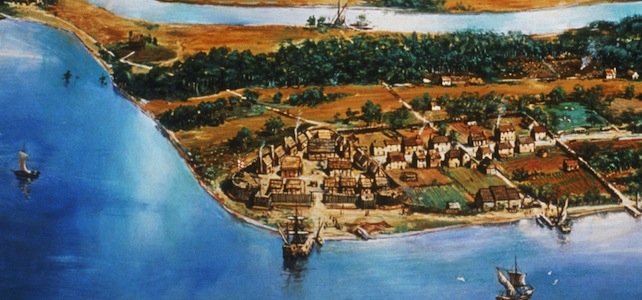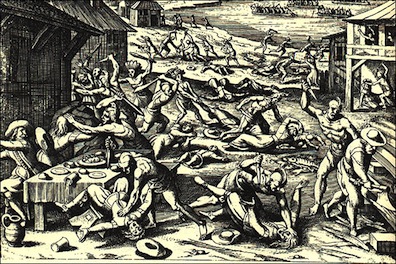Why Was the Jamestown Colony Such a Mess?
Dan Bryan, February 8 2015
Jamestown, Virginia was the first English colony in what is now the United States. While it lives on in American history and folklore, the actual operation of the colony was a fiasco. Colonists could expect to die within a couple of years, food was in chronically short supply, and American Indian resistance nearly ended the settlement. What were the specific reasons for this state of affairs? Were the colonists merely incompetent, or were they doing their best under the circumstances of the settlement?
A Brief Overview of Jamestown and the Virginia Company
The Jamestown Colony was birthed from the marriage of classical mercantilism and private enterprise. The Colony was formed by the Virginia Company, which in turn was chartered by the King James I. It was devised as a way for the English Crown to colonize North America without bearing the costs of the operation. Instead, private investors financed the colonization for a share of the profits.
Profits, however, were not in store. The colony barely survived its first few years, generated no profits, was riddled by disease and hunger, and lived under constant threat of attack and destruction. The location of Jamestown itself was not conducive to success -- it was on a small island of questionable fertility. Even today, the island has little economic value and serves only as a historical relic. The Virginia Company itself lost its charter in 1624, from a combination of financial turmoil and concern about the devastating mortality rate in the colony.
So again, the question arises, why was a location chosen that seemed so ill-suited to success? Were the first colonists ignorant of the land or did they do their best under the circumstances? And why did it take so long for the Virginia of colonial repute to establish itself? Here are some of the reasons.
Ecology of Jamestown and the Surrounding Area
Ecologically, Jamestown was a terrible place to start a colony. Yet by settling there the first colonists were largely doing what they were told. The Virginia Company, unfamiliar of course with local geography, had dispatched them from London with a specific set of instructions. Charles Mann summarizes them:
They instructed the colonists to settle far from the ocean, "a hundred miles from the river's mouth," which would minimize the chance of sudden assault by Spanish ships. And they told them to make sure the settlement was close to a deepwater anchorage, so they could lay up "provisions with ease." In all they did, the directors warned, the colonists should act with "great care not to offend the naturals [Indians]."
In the context of such instructions, the colonists could not have found a better spot than Jamestown. It was far enough inland to be impervious to surprise assault from the sea, yet close enough the Chesapeake to be accessible. It was also unoccupied land, minimizing the tension with the local Powhatan Confederacy.
Like most things that lay unclaimed, however, Jamestown was free for a reason. It was marshy, infested with mosquitos, and without reliable water. For the James River flows slowly in the best of times, and during the summer did not contain enough water to prevent the brackish upflow of the Chesapeake from reaching the colonists.
The Prevalence of Typhoid, Dysentery, and Malaria
Poor water quality almost destroyed the Jamestown colony. Most colonists were dead within two years. Between 1609 and 1610 the population dropped from 500 to 60, and the colony was nearly abandoned, an episode known as "starving time".
Colonists were left in many cases to drink directly from the James River, which was brackish and impure. Thus, they likely suffered greatly from typhoid and dysentery. Although researchers are still investigating this theory, though it seems to be increasingly accepted. Without reliable medical treatment, the fatality rate from typhoid is quite high and it certainly could have decimated the Jamestown colony.
Malaria would later become a problem, beginning with the importation of Africans in 1619. These individuals likely introduced the P. falciparum strain of malaria, which is strongly virulent and which the colonists would have had little immunity against. From the start, however, the more European, P. vivax strain was a chronic, if not entirely fatal malady of the colonists.
Hostility of the Powhatan Confederacy and Other Tribes
Powhatan was not pleased when the colonists arrived. The Confederacy he led controlled the area, and it was only natural that new arrivals would be seen as a threat. However, there was a small amount of trade that took place, providing the Indians with guns, axes, copper, and other goods. In any case, the colonists seemed so inept and near extinction that they must have hardly seemed a threat.
In the meantime, the Powhatan guarded their land with vigor. Colonists who left the confines of Jamestown faced abduction, injury, or death. In fact, the famous John Smith was captured by Indians in the first place during an attempt to head upriver in a boat (believe it or not, Smith was attempting to find a water route to the Pacific Ocean). In all cases, any attempt by colonists to settle more fertile land during these first few years ended in failure.
It was only once a fragile peace was reached between the Powhatan and the colonists that any kind of a foothold was gained. This peace was achieved via the celebrated marriage of Pocahontas, Powhatan's daughter, with John Rolfe. It provided an interlude of a few years in which the colonists drove further inland and began to establish tobacco fields and settled farms.
This interlude came to an end in 1622, when the Powhatan launched a desperate, surprise attack to stem the tide of English settlement. Although this attack killed 347 colonists, or about a quarter of the English population, it failed at its larger objective. The larger colony survived and launched reprisals, and the Powhatan were driven further away from the coast. Though individual Virginians would remain in danger of Indian attack for over a hundred years, the colony as a whole was no longer threatened with extinction.
Conclusions on this Matter
The list is not meant to be exhaustive. Rather it is meant as a starting point. For a very long time, natural and ecological concerns were hardly examined when it came to history. Instead, political concerns were all-encompassing, and man was seen as master of the environment and of his own fate. Fortunately, modern historical scholarship has provided a more detailed look at early Jamestown and expanded our perception of its place in the American continent of the time.
It is important to note that only once the Powhatan were weakened and pushed back from the James River and the Chesapeake, could the Virginia Colony begin to thrive as a venture. Eventually the rise of tobacco planting provided the economic basis for prosperity and expansion, and a minority of the settlers became quite wealthy. The fact that most of this happened outside of Jamestown, however, only reaffirms the poor quality of that location for launching a colony.
Recommendations/Sources
- Thomas Mann - 1493: Uncovering the New World Columbus Created
- James Horn - A Land As God Made It: Jamestown and the Birth of America
- William M. Kelso - Jamestown, the Buried Truth
- David A. Price - Love and Hate in Jamestown: John Smith, Pocahontas, and the Start of a New Nation


